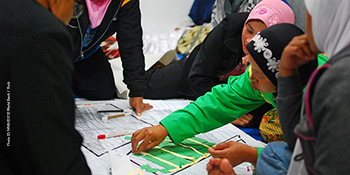Indonesia has invested significantly in restructuring its governance institutions to transform its disaster governance system from focusing on post-disaster response to taking a comprehensive and integrated approach.
Source: PreventionWeb.net

Indonesia is among the countries in the world with the highest risk from environmental hazards and climate change impacts. Following the devastating impacts of the 2004 Indian Ocean Tsunami and guided by the Hyogo Framework for Action 2005–2015, Indonesia invested significantly in restructuring its institutions, laws and policies in order to transform its disaster governance system from one focusing on post-disaster response to one taking a comprehensive and integrated approach to address the increasing disaster and climate-related risks facing the country.
The foundation for the establishment of new institutional and regulatory frameworks for disaster risk reduction (DRR) was the adoption of Law 24/2007 on Disaster Management and the formation of the National Agency for Disaster Management (Badan Nasional Penanggulangan Bencana, BNPB) and the Local Agency for Disaster Management (Badan Penanggulangan Bencana Daerah, BPBD).
These changes led to a realignment of the roles and responsibilities of the different line ministries with the aim to enable a more holistic approach to reducing risk and to better link DRR with climate change adaptation and socio-economic development processes. Such efforts are continuing under the Sendai Framework for Disaster Risk Reduction and are in line with achieving Priority 2 on Strengthening disaster risk governance to manage disaster risk.
But it’s not just in the government where progress has been made in better preparing Indonesia in facing future risks. Non-government organizations (NGOs) and community-based organizations (CBOs) also play an important role in enhancing the resilience of different social groups through a multitude of resilience building initiatives at the community level – from faith-based organizations that help to communicate disaster risks to their followers, to women’s organizations that help households to diversify their livelihoods and recover faster after disasters, to organizations that help to create inclusive DRR approaches for people with disabilities.
Collectively, these organizations help to achieve Priority 3 on Investing in disaster risk reduction for resilience of the Sendai Framework by broadening the dialogue between those in power and those at the margins of society. The involvement of a multitude of actors is crucial in bringing together different types of knowledge, co-producing new knowledge, reconciling the values, priorities and preferences of different stakeholders, creating joint ownership, and in engaging in collaborative learning in the definition of problems and acceptable solutions.
Due to its experience of the 2004 tsunami, Indonesia has much to offer with respect to Priority 4 on Enhancing disaster preparedness for effective response and to “Build Back Better” in recovery, rehabilitation and reconstruction. For example, in Banda Aceh, the customary institution Panglima Laot was shown to be instrumental in the recovery of Aceh’s coastal fishing communities because people had trust in the institution, its role as a mediator between communities and government and NGO actors, and its leadership in implementing, monitoring and evaluating livelihood recovery programmes that addressed community needs. This experience offers important lessons for actors engaged in localized post-disaster operations that aim to build resilience on leadership, community engagement and people-centred recovery approaches.
With respect to Priority 1 on Understanding disaster risk much progress has been made in Indonesia and elsewhere in broadening the scope from assessing hazard risks and impacts upon communities and societies to enhancing our understanding of vulnerability and resilience. However, much more needs to be done to understand how disaster risk is created through certain development choices and pathways, and how contextual and interlinked socio-cultural, geo-political, economic, and biophysical factors drive different levels of vulnerability and resilience within and across communities, cultures, and nations over time.
Design and development by Soapbox.
